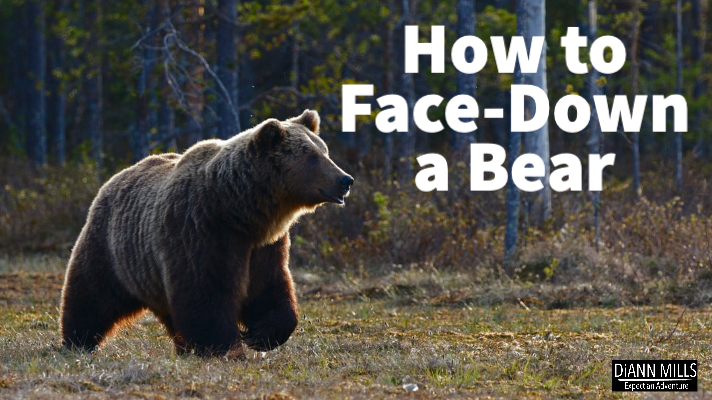By DiAnn Mills @DiAnnMills
Today’s Guest Blog Post Written by Curt Iles @CurtIles
I’ve got hiking fever. It strikes me several times a year and I find my heart, if not my feet, on a trail in Arkansas or the Appalachian Mountains. In both of these hiking locales, encountering black bears does occur. I want to share a few good bear stories along with information from a “Bear Facts” brochure from one of my favorite hiking places, Great Smoky Mountain National Park.
First of all, you don’t want to fight a bear. For one simple reason: you will lose. So this brochure is about safely encountering bears in their habitat of the mountains. At the end of these ramblings, I have a few spiritual insights to add.Don’t turn your back on a bear
I’ll never forget my first bear encounter in the Smoky Mountains. I walked right up on one near the top of Shuckstack Mountain. There we were face to face and he seemed surprised, while I was terrified. Following the wise guidelines, I quickly backed away putting space between us as quickly as possible. I’m not sure if I wet my pants, but it wouldn’t have surprised me one bit!
I once saw a picture of a group of Asian natives in Bengal Tiger country. The native in the back of line had a human face mask worn on the back of his head. It was a guard against the tendency of a stalking tiger to slip up behind a person. They’d found that the face mask amazingly caused tigers not to pursue or pounce.
So don’t turn your back on a black bear, (or for that matter, a tiger either.)
Don’t get complacent
Most hikers and tourists get into trouble with bears because they get too comfortable and forget they are in the presence of a truly wild and dangerous animal.
I was told this story by an Appalachian Trail (AT) hiker: a group of tired hikers was cooking supper over a shelter campfire in the Smoky Mountains.
Suddenly a good-sized bear ambled out of the nearby woods. He had a comical gait and seemed to nearly be grinning as he squatted near the hikers. They were all amused and quickly got their cameras to take pictures of the friendly bear.
Just as quickly and suddenly, the bear charged the group. His intended target was not them, but a food bag beside one of the hikers.
The bag’s owner was just taking a photo of the bear as it charged. (The narrator called it a “true Kodak moment.”) Being a long-distance hiker and low on food, the man diligently fought the bear over his food bag. Granola bars flew everywhere as man and beast vainly vied for possession of the bag.
The bag finally ripped and the bear happily trotted off with the bag and its remaining contents.
It all happened because they were complacent with an approaching (and granola- loving) bear.
A sidebar to this story. This bear had the appropriate nickname of “Sneaky.” Sneaky the Bear made his living by enacting this same scenario over and over at this campsite. He was eventually captured by park rangers and removed. (I assume he is now doing this same routine at Jellystone National Park.)
Don’t get complacent!
Beware of erratic behavior
I guess “Sneaky’s” above behavior was erratic. Once I saw a large bear eating berries. While a long distance away, the bear stood on its hind legs, snorted aggressively, and watched me. That was enough erratic behavior for me to choose another path. As I left, I then noticed two nearby cubs. They were the source of the mother bear’s behavior.
Don’t run
That is much easier written about than done. But running from a bear is an invitation to be chased. They can sense fear and when you run, they see fear and will react accordingly.
I always think of Shelby Foote’s anecdote in his book, The Civil War. He tells of a Tennessee Confederate soldier named June Kimball at the battle of Gettysburg. Kimball was part of the famous advance called “Pickett’s Charge” where the Southerners were repulsed by the union soldiers who shot from behind stone walls.
When June Kimball realized that to advance further was only to join the other thousands dead or dying, he said, “I began walking slowly backward. I was determined if a Yankee bullet got me, it wouldn’t hit me in the back. I walked probably a half-mile backward, still facing the enemy, until I knew I was out of range. Then I turned and made tracks for the safety of our lines.”
If you come face to face with a bear, don’t run.
Talk strongly, but don’t argue
Once, I was on the Appalachian Trail (AT) with my son Clay and nephew Adam. I had told them we would end our trip after we saw a bear.
We cooked supper one evening at our shelter as the sun went down and darkness came to the mountains. (The rock shelters on the AT had a hurricane-fence covered open front with a gate. This allowed hikers to sleep away from the bears. It was kind of a reverse zoo. The humans were inside the fenced area and the bears, who roam mainly at night, were outside.)
At dusk, Clay and Adam went to wash our supper dishes and soon came sprinting back saying they’d encountered a bear. I laughed at their fear until my flashlight shined the bear’s face as he came right into our campsite.
As we quickly gathered our cooking gear (and food bag!) and retreated behind the fence, I talked strongly to the bear letting him know this was our campsite, and he was not welcome. This caused him to slink back into the dark.
He soon returned and quickly commandeered the campsite. The only strong talking was our hollering to get inside as we closed and locked the gate. I wasn’t going to argue with him. The campsite was now his.
As we watched Mr. Bear in the distance, Adam innocently asked, “Does this mean we can go home now, Uncle Curt.”
I had no argument with that either. We hiked out the next day and drove home to Louisiana.
I’ve been on more fine hiking trips since then. However, it was, to my knowledge, the last trip either Adam or Clay ever went on.
Travel in groups
Most trouble between bears is avoided if hikers will travel in groups. One of the most recent human-black bear fatalities in the Appalachians was a female camper traveling alone. There is truly safety in numbers.
In closing, I’d like to mention a few spiritual applications. The Apostle Peter wrote, Be sober, be vigilant; because your adversary the devil walks about like a roaring lion, seeking whom he may devour. I Peter 5:8
If Peter had been in the Smokies, he would have compared the devil to a black bear. He calls him our adversary and tells us to be vigilant and on guard.
- Don’t turn your back on the devil
He is real and active and always wants to destroy the lives of humans.
- Don’t get complacent
When we picture Satan in a red suit with a pitchfork, we underestimate his intent. Like Sneaky the Bear, who looked friendly but was sinister, Satan can seem “an angel of light” but his motivation is always evil.
- Beware of erratic behavior
The devil wants to attract and disarm us with his appeal and enticement. Beware and move back.
- Don’t run.
Stand your ground, but also don’t stay around waiting for trouble. Walk backward and get away.
- Talk strongly, but don’t argue.
Jesus talked strongly to Satan. He used the powerful word of God to each of Satan’s temptations during the 40 days. We are best equipped against the enemy when we know, and use, God’s word against temptation. However, don’t waste your time arguing with the enemy. Get behind “the fence” and get safe.
- Travel in groups
One of the reasons I advocate being part of a good church is there truly is safety in numbers. I need the encouragement and stability of a positive group to keep me safe and straight. I find that in my local church.
Curt Iles

Curt Iles is a native of Louisiana’s Pineywoods region. He is the author of thirteen books and over 1200 blog posts at www.creekbank.net His writing celebrates the history, culture, and people of western Louisiana. Before becoming a full-time author, Iles worked as a teacher/coach, school administrator, youth camp manager, and missionary. His life statement is to be a man God can use, be an encourager, and be respected by those who know me best (my family). He and his wife DeDe live in Alexandria, Louisiana.
Learn more at www.creekbank.net
Thanks again Curt for sharing your adventure, wisdom, and humor.


